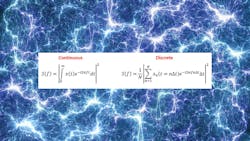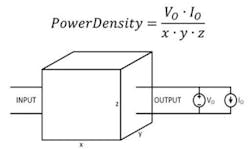What’s the Difference Between Power Density and Power Spectral Density?
This article is part of the Power Management Series: Delving Into Power Density.
Members can download this article in PDF format.
What you'll learn:
- Fundamentals of power spectral density.
- Defining laser-beam power density.
The basic definition of power density is the rated (or nominal) output power of a device divided by the volume (volume = x · y · z) occupied by the device (Fig. 1). Common units of measurement for power density can be watts per cubic meter (W/m3) or watts per cubic inch (W/in.3).
Power Spectral Density Basics
Power spectral density (PSD) is the measure of a signal's power content versus frequency. PSD gives designers an idea of how the power of a signal is distributed over frequency. PSD is usually chosen to characterize random broadband signals (Fig. 2).
When we have a discrete case, as in Figure 2, the PSD can be calculated by using the fast Fourier transform (FFT) algorithm. Also, in the discrete case, the time-domain signal x(t) will contain N samples, where n is the sample number (total sampling time of T = NΔt). The lower integration limit, in the discrete case, will start at t = 0 to account for causal signal behavior.
Designers and scientists use stochastic processes as mathematical models of their systems as well as phenomena that can seem to vary in a random manner.
Power spectral density also can be calculated quite simply via different methods; one of them is known as a modified periodogram method. This technique is an estimate of the spectral density of a signal, which is the windowed squared magnitude of a FFT. Periodograms can typically be used to identify the dominant cyclical periods (or frequencies) of a time series.
Power Density of a Laser Beam
The power density (a.k.a. irradiance) of a laser beam is defined as a ratio of power (P) in watts (W) to the cross-sectional area (I = W/cm2). The Laser Power Density Calculator is pretty handy.
Examples of a Laser Beam’s Power Density
- Cutting sheet metal: Power density here will define how quickly a laser beam can perform a good quality cut.
- In laser surgery, the power density of a laser scalpel will need to remain in a narrow range to perform successfully.
- When testing a laser for safety, the power density will need to be less than a specifically designated level to be safe for the human eye.
Laser beam users need to know the overall power of the beam, while keeping in mind the level of power reaching the area of interest.
Summary
Power density is defined as the rated (or nominal) output power of a converter, which is then divided by the occupied volume of that converter.
Power spectral density will give an idea as to how the power of the signal is distributed over frequency. PSD is defined as a measure of a signal's power content versus frequency. PSD is typically employed to characterize broadband random signals. The amplitude of the PSD becomes normalized by the spectral resolution used in digitizing the signal.
Read more articles in the Power Management Series: Delving Into Power Density.
References
1. Delving Into Power Density | Electronic Design
2. Power Density: What All EEs Need to Know | Electronic Design
About the Author

Steve Taranovich
Freelance Technical Writer, Phoenix Information Communication LLC
Steve is a contributing editor to Electronic Design.
Author of the non-fiction “Guardians of the Right Stuff,” a true story of the Apollo program as told by NASA and Grumman Corp. engineers, an astronaut, and technicians.
Experienced Editor-In-Chief of EETimes/Planet Analog and Senior Technical Editor at EDN running the Analog and Power Management Design Centers from 2012 to 2019.
A demonstrated history in electronic circuit design and applications for 40 years, and nine years of technical writing and editing in industry. Skilled in Analog Electronics, Space-related Electronics, Audio, RF & Communications, Power Management, Electrical Engineering, and Integrated Circuits (IC).
1972 to 1988 worked as a circuit design engineer in audio (8 years) and microwave (8 years). Then was Corporate Account Manager/applications engineer for Burr-Brown from 1988 to 2000 when TI purchased Burr-Brown. Worked for TI from 2000 to 2011.
Strong media and communication professional with a BEEE from NYU Engineering in 1972 and an MSEE from Polytechnic University in 1989. Senior Lifetime member of IEEE. Former IEEE Long Island, NY Director of Educational Activities. Eta Kappa Nu EE honor society member since 1970.


